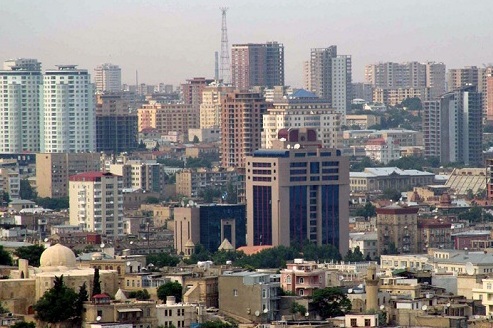Real estate growth brings new appearance to Baku

By Mushvig Mehdiyev
The boom in investments in the real estate sector in Azerbaijan -- most of it taking place in the capital Baku -- began approximately eight years ago, with numerous international companies coming to the country to implement their grand real estate projects. Over time, new developments in the real estate sector paved the way for other infrastructure projects such as construction of new bridges, roads and road expansions to ease traffic congestion.
Baku, which blends the ancient traditions of architecture with modern elements, has turned into one big construction site. Every day, while walking or driving around the city, one can witness mass construction or renovation projects everywhere.
Over the last two years, the government has promoted widespread renovations of the old buildings in Baku, especially of the ones off the main streets and avenues.
Significant interest in the construction market of Azerbaijan is also demonstrated by the increasing number of collective stands of foreign countries. The International Exhibition BakuBuild-2012 launched in mid-October, which is held annually by Iteca Caspian, confirmed that the construction exhibition is among the top three by the level of foreign companies' interest in it. The foreign interest in the domestic construction sector is not limited to the participation in exhibitions and sale of products and services there.
"According to recent results, about $16 bn has been invested in the economy from all sources," the head of the International Relations and Information Department of the Azerbaijani State Committee for Urban Planning and Architecture, Jahangir Gojayev, said. "A significant amount of these investments falls to the construction sector, which has gained high growth rates in the past few years again."
In general, over the past 15 years, about 18-20 per cent of direct foreign investment in the Azerbaijani economy came from the construction sector.
Not surprisingly, the local construction sector, which has about 1,500 companies and over 64,000 employees, has steadily maintained its positive growth over the last two years. According to the State Statistics Committee, the volume of housing construction in the country reached 1.922 million square meters in 2012, which is 7 percent more than in the previous year.
Of course, the stability and growth of Azerbaijan's construction market are largely dependent on large-scale projects being implemented by the government. And judging by the plans of the state, this growth will be maintained further. In particular, many of the participants in this construction exhibition were interested in the regional development plan of Greater Baku 2030.
Over the past two years, Azerbaijan has almost completed the
drafting of a master plan for the development of the capital and
its suburbs. In the course of the 35th meeting of the
Intergovernmenta
Town planning tasks are primarily focused on the principle of improving the quality of life: to create a convenient residential environment, improve the environment throughout the territory, raise engineering support to internationally accepted standards, improve modern passenger transport, etc.
To achieve this goal, the planning of industrial, residential, administrative, recreational, and other areas in Greater Baku will cover the whole of the Absheron Peninsula, including the territory of Sumgayit and Khirdalan and part of the Absheron administrative region with a total area of over 250,000 hectares. The integration of these areas in the single urban development plan of Greater Baku is necessitated primarily by significant regional economic development and growth in demographics. In particular, in recent years the growth of migration to the capital and its suburbs has caught up with the natural population growth in the city.
Approximately by 2030, some 22,000 hectares of oil-field areas will be rehabilitated, and most of them will be used as forest park zones. It is also planned to landscape no less than 34,000 hectares currently used by industrial entities or abandoned areas: parks and gardens will appear there, and in the process of improving those areas, the road network will increase by hundreds of kilometers.
Although the approval and launch of the regional development plan of Greater Baku is a matter of the near future, many of the projects envisaged by this document have already been successfully implemented in recent years. For example, since 2006, Baku has implemented ambitious projects for the reconstruction of the road network: in a short period of time, hundreds of kilometers of new highways were built and existing roads were reconstructed. Dozens of highway bridges, tunnels and pedestrian crossings at major road junctions were built, and their number is much higher than during the entire Soviet period. Over the past few years, drastic changes affected one of the main attractions of the capital - the seaside park (Boulevard). Its length has more than doubled - to 6.5 km, and in the future, the total length of the boulevard will exceed 11-12 kilometers.
These road and recreational projects and, of course, major residential and administration construction work in the capital, became one of the most important factors contributing to the dynamic development of domestic construction companies and plants manufacturing building materials, as well as the growing interest of foreign companies in Azerbaijan.
Here we are to serve you with news right now. It does not cost much, but worth your attention.
Choose to support open, independent, quality journalism and subscribe on a monthly basis.
By subscribing to our online newspaper, you can have full digital access to all news, analysis, and much more.
You can also follow AzerNEWS on Twitter @AzerNewsAz or Facebook @AzerNewsNewspaper
Thank you!
